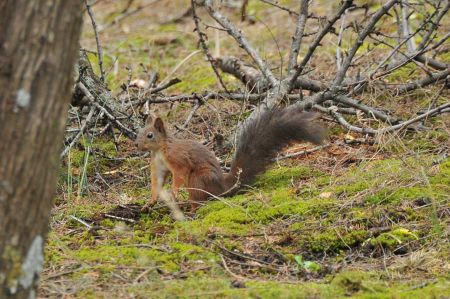Meeting an active squirrel at the Castle in Ohrid
- Written by Portal Editor
Slowly more signs of appearing autumn are noticeable, even at Lake Ohrid, with heavy rain showers, which already have increased the level of the lake quite a lot, the now multicolored forests seem to disappear in the clouds.
In a rain break, Julia, Davide, Lennart and me were on the way for sightseeing associated with some purchases in Ohrid, the former Roman town Lynkestis, especially because Julia and Davide have not seen the site so far. Noticeably more empty it has become, what we, for sure, prefer, since the usual tourist bustle in the months of July and August is finished. For the traders and residents of the city, the season is almost over and as always too short for getting enough income for the following winter period.
Following the wooden path along the lake, while still some swimmers can be discerned in the lake, the promenade with its inviting restaurants is rarely visited too anymore. We then climb up to the chapel Sveti Jovan Kaneo, despite mostly gray sky, we enjoy the view of the lake, before continuing uphill to Ranochristijanska Basilica. Lennart, in between, followed a different path, which should lead to a bay below the castle, which he intended to explore. The walk up to the fortress takes us through a forested area, as we noticed first carefully rustling leaves, then came into visual contact with a squirrel that deals with the creation of his winter supply. We stopped and watched the activities more close.
Squirrels place stocks for the winter around their nests, ours had found a hazelnut to hide. For that it is important that they can find enough food to fill the stockpile. Not always being able to find them again, in severe winters a lot of animals die because of no food. They bury the food either in the soil, often near tree roots or tuck them into cattle columns or crotches as winter supplies.
In winter the inventories often serve as a sole source of nutrition. If the buried inventories are forgotten in their position, the seeds begin to germinate in the spring. Therefore one speaks of the squirrels that they have an important role in the renewal and rejuvenation of the forest. For the recovery of the collected food in the fall the sense of smell is very important. Although squirrels remember some of their buried inventories, they are not able to memorize all the hidden goods.
Squirrels are diurnal, really very active and fast. We wanted to take photos, but the animals climbed very clever and move forward in bursts, their movements are very fast and accurate, hardly a good chance for a photo. It does not matter if they climb up a tree trunk or a rough house facade or climb down headlong. If they climb down, they turn their back paws outwards and back. With a leap, the animals can easily bridge distances of four to five meters. Squirrel venture, due to their low weight, even on very thin branches, while they always move jumping forward and are thus absolutely superior to any pursuers.
To Sleep and rest squirrel build nests, called coble. It is hollow spherical structures that are placed in a crotch or at the base of a branch, usually occur at altitudes greater than six meters. The diameter of the cavity is about 30 to 50 cm, while the inside diameter of 15 to 20 cm. The coble is built of twigs, needles and leaves, inside it is lined with moss, leaves and grass. It is almost waterproof, through the thick walls it offers a good thermal insulation in winter. The coble has at least two loopholes, one of them always downwards, because squirrels, unlike birds, going from bottom into their homes.
The construction of a coble takes about three to five days. As it happens quite often the animals have to move because of parasites or interference, so they build two to eight nests and do not always use the same. A distinction is made between sleep cobles for the night and shadow cobles for resting periods during the day.
In the ancient world peoples view on the animal was little curious because they thought, that squirrel with its mighty tail could give shade to itself, their Greek name "shadow tail" still shows the relation. That squirrels were once hunted and eaten by humans is correct since some findings of remains in the Neolithic lake dwellings of Switzerland have demonstrated.
Squirrels even belong to the omnivores. The nutrition of animals varies depending on the season. It primarily consists of berries, nuts and other fruits and seeds. Squirrels do not stock any inventory in cobles. The squirrel loves to live in old forests with closed canopy, like coniferous or mixed forest.
We succeed for some more photos when Lennart joined us again after his special field trip to the bay "Plaza Labino", later we continued our way to city centre of Ohrid.
Please read as well:
Puzta cattle and the Natural Park Zasavica
Mediterranean gulls following ferry
-
-
-
-
-
-
-
-
-
-
-
-
https://www.alaturka.info/en/life/fauna/3492-meeting-an-active-squirrel-at-the-castle-in-ohrid/amp#sigProId16767efd97
